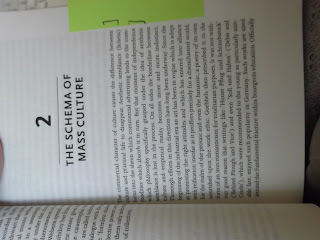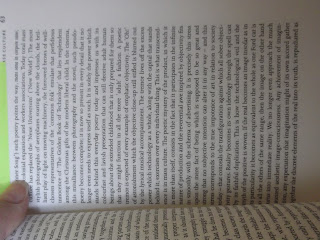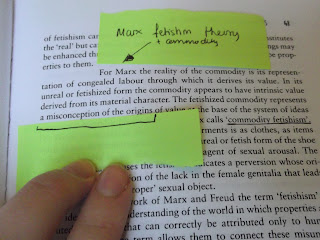I decided to go through my lecture notes over the year, and find and specify information I could use directly in relation to my assay title of:
"Consumerism as a form of unconscious manipulation"
What is capitalism
Bourgeoisie, the commodity, proletariats
_ Control of the means of production in private hands
- Markete where labour lpower is bought and sold (inc humans - almost commodities)
- Production of commodities for sale
- Use of money as a means of exchange
- Competition / meritocracy
'Best suceed' etc
Stature in society , to be at the top, its a competition
Marx concept of base / super structure
Base (economic)
Forces of production - Materials, tools, workers, skills, etc
Relations of production - Employer, class, master, slave etc
Superstructure
Social institutions - Legal, political, cultural (art , design, education) Can be traced back to issues of class, gender/racial politics, everything bears this stamp
Forms of consciousness - Ideology
"The history of all hitherto existing society is the history of class struggles."
Capitalism (the society were in) produced laws, culture, law, politics, education which reflects the capitalist attitude
Base > Determines content and form of > super structure
> Superstructure > reflects form of legitimises> base
Educator > instrcuts (form of education) Work > instructs (act although its normal, marxist reading into education)
Super structure > Education, family, religion, mass media, politics > Base - Relations of production, means of production
Super structure - maintains and legitimates the base
Base - Shapes the structure
Reading - Marx, (1857) "contribution to the critique of political economy' :
In conclusion:
Society produces our life's, not us, the accident of our birth produces what were are going to be. Where we are in life we are forced into relations and situations, these relations which reflect the society we live in. the base determines the superstructure, which determines our consciousness ( to rebel, to take it as normal etc) our society condition everything, philosophy, interaction etc. Social being dtermines our consciousness. Change the base> change our attitudes, arts and culture.
One can have an ideology, system of ideas and beliefs (e.g Christianity, conservatives)
Ideology - The way in which a system of ideas masks, distorts a way of thinking about the world, which covers ove glass/gender/race discriminations. Legitimises over certain classes/races - false consciousness - exploited
Through buying, consuming we make ourselves poorer through buying, never gain status in society.
Commodity fetishism (marx, capital Vol.1)
Fetisise commodities
Something that gets in the way of something else, used as a substitute
Trainers taking appearance of 'cool' , you being 'cool' mediated by trainers
Adbusters & cultural jamming
'Buy nothing day' etc
techniques - do something to a piece of work / object to alter message. E.g - `billborad - used to give a message - Distort this - its still a strong message.
Look at youtube videos
Panopticism
- Conformity
- Being watched subconsciously makes you act in a certain way
Michel Foucault - Interested in the mechanism for discipline, Panopticon secluding people to be on their own, the way in which its a metaphor for the way society controls its citizens, an allergy of how we're controlled in our day to day lives. Panopticon symbolises our day to day lives. Figure for how we're controlled
With her book, 'Decoding advertisements', Judith Williamson explored and analyses what can be 'seen' in advertisements. Believing it's an "inevitable part of everyone’s lives…" stating that you don't even have to be 'directly involved in the media, it's all around us". That image within our urban surroundings are 'inescapable'. She states that advertisements have their own independent reality, becoming separate from the material medium, which carries it. She agrees that its main function is to sell things, but that it has another, to create structures of meaning. In order to sell us something advertisers make the properties of a product 'mean' and connote something to us.
"Advertising sets up connections between certain types of consumers and certain products."
Using signifiers and what is signified to create the connection. "Taking the sign for what it signifies, the thing for the feeling." (Williamson, J, 'Decoding advertisements', 1978).
"People are identified by what they consume rather than what they produce."
We are no longer an image of our skills but by our materials and commodities. She states we are made to believe we can rise or fall within society by what we can afford, and can't, obscuring actual class basis. Class difference has lost meaning. Apparently we can now purchase our place in society. As we feel a need to belong, the mass media provide this 'Place to belong' to an extent.
Within a consumerist society, we are impaled by constructed false needs
ADAM ARVIDSSON
'Branded consumer good are ubiquitous and have achieved a perhaps unprecended importance in the lives of some consumers groups."
"Companies give increasing importance to their brands as marketing tools"
"Brands thus represent the additional value of the informational content of commodities."
"this can be relations between the brand and it's distribution between the brand and it's customers and between the consumers themselves in terms of brand communities and the importance of brands for personal identity."
300 Word evaluation - an overview of her opinion towards advertising
With her book, 'Decoding advertisements', she explores and analyses what can be 'seen' in advertisements. Believing it's an "inevitable part of everyones lives..." stating that you don't even have to be 'directly involved in the media, it's all around us". That images within our urban surroundings are 'inescapable'.
Williamson states that advertisements have their own independent reality, becoming separate from the material medium which carries it. She agree's that the main function is to sell thing, but that it has another, to create structures of meaning. In order to sell us something advertisers make the properties of a product 'mean' and connote something to us.
She suggests that advertisements provide a structure, transforming the language of objects to that of people.
"Advertising sets up connections between certain types of consumers and certain products."
Using signifiers and what is signified to create the connection.
"Taking the sign for what it signifies, the thing for the feeling."
Williamson believes people and objects become interchangeable, advertising is selling more than just good, but by providing a structure, in which people and goods are interchangeable, are selling people, themselves.
"People are identified by what they consume rather than what they produce."
We are no longer an image of our skills but by our materials and commodities. She states we are made to believe we can rise or fall within society by what we can afford, and can't, obscuring actual class basis. Class difference has lost meaning. Apparently we can now purchase our place in society. As we feel a need to belong, the mass media provide this 'Place to belong' to an extent.
Overall Williamson sums up advertising as giving good a social meaning.
Reference - Williamson, J, 'Decoding Advertisements', 1978
SEMIOTICS
What is semiotics?
A science of studying signs - Something that gives a meaning in culture.
The study of how things mean, not what things mean - Cultural code.
To read culture in the same way we read language.
Fashion is a cultural code. A 'punk like' attired man - a rebel subverting. Image of man in tie and suit - societys consensus - smart, status, business, societies view. Tie - purely symbolic - no function.





















